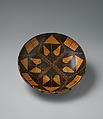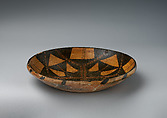Platter
Not on view
Ceramic wares modeled by Berber potters of Algeria's mountainous Great Kabylia region respond to functional needs combined with aesthetic intention. Made to carry water, conserve foods, or prepare and serve meals, their often simple shapes are decorated with elaborate patterns that reflect a strong sense of geometric design and answer a desire to embellish one's interior. Coil-built, red clay feast platters such as this example were used to serve couscous during wedding and other special occasions.
Combining checkerboards, crosses, circles, and triangles, the geometric patterns adorning such platters initiate at the center and develop towards the rim in contrasting black and beige pigments, with red highlights. Attention is paid to creating an overall design, as well as patterns within patterns, that incorporate alternating and opposing elements, instilling a sense of visual equilibrium. Berber potters use conventional motifs, but apply and combine them in ways that reflect their own aesthetic sensibility. The results are wares that simultaneously present strong geometric frameworks and a sense of freedom and ingenuity.
Crafted by women who pass along their knowledge generationally from mother to daughter, the decorated motifs are imbued with symbolic meanings. The names and meanings given to these motifs are open to personal interpretation, although they often highlight the importance of both supernatural protection and nature -- particularly fecundity -- in Berber tradition. The same patterns are found on a variety of surfaces and media, from woven textiles, and jewelry, to the tattoos embellishing women's skin. While ceramic wares are found throughout the Great and Small Kabylia regions, they present a range of regionally distinct styles. Research suggests that this platter, together with the other nine in the Met's collection, come from the Djurdjura region, south of Tizi Ouzou.
Due to rights restrictions, this image cannot be enlarged, viewed at full screen, or downloaded.
This artwork is meant to be viewed from right to left. Scroll left to view more.



